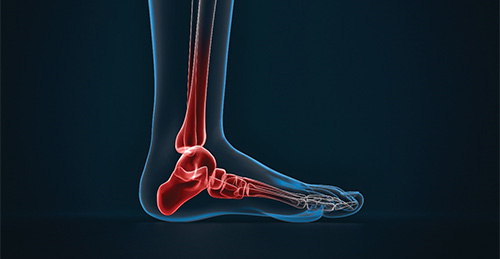
Dr. Bonnie Chien
One of the hardest complications to treat in orthopedic surgery is arthroplasty-associated infection, or periprosthetic joint infection (PJI). “While relatively rare, periprosthetic joint infection following joint replacement surgery remains a dire complication, with rates that are higher for total ankle arthroplasty at 3 to 5 percent, compared to 1 to 2 percent for primary hip and knee arthroplasty,” says Bonnie Y. Chien, MD, an orthopedic surgeon specializing in foot and ankle conditions at NewYork-Presbyterian/Columbia. “Over the past 10 years, the number of ankle replacement surgeries has been increasing, and with that there has been an associated increase in the number of infections.”
A PJI occurs in a previously replaced joint and it involves an interaction between microorganisms, the implant, and the host’s immune system. There is a myriad of bacteria, and some fungi, that can cause a PJI, and treatment often involves long-term antibiotic use and, in most cases, revision surgery.
Assessing Patient Risk for PJI
Although joint replacement surgery inherently carries a risk of infection for anyone, there are some preexisting conditions that increase one’s risk, including:
- Obesity
- Diabetes
- Kidney dysfunction
- Heart failure
- Use of immunomodulating medications (such as steroids or biologic therapies)
- Smoking
While relatively rare, periprosthetic joint infection following joint replacement surgery remains a dire complication, with rates that are higher for total ankle arthroplasty at 3 to 5 percent, compared to 1 to 2 percent for primary hip and knee arthroplasty.
— Dr. Bonnie Chien
PJI risk has been measured with the Mayo Periprosthetic Joint Infection Risk Score, a prognostic scoring system developed for stratifying infection risk for patients undergoing total hip or total knee arthroplasties. Dr. Chien and colleagues at several orthopedic surgery programs around the country recently conducted a study to see if the Mayo Score would be applicable in total ankle arthroplasties (TAA).
Lateral view of the ankle
“The risk factors for PJI following TAA mirror those that affect patients undergoing hip and knee replacement surgeries, but the Mayo Score has not yet been used for TAA,” says Dr. Chien. “Our research sought to identify which of those factors are significant for patients undergoing TAA and if the Mayo Score could be used as a tool to help surgeons decide if the risk of infection would delay or preclude their patient from undergoing TAA.”
The research team analyzed specific risk factors, including body mass index, whether the patient had undergone a previous arthroplasty, presence of immunosuppression conditions, the American Society of Anesthesiologists (ASA) physical status classification score, and procedural time. This study, published in the March 22, 2023 issue of Foot and Ankle International, looked at 405 consecutive TAA cases performed by one surgeon from October 2012 to January 2022.
“The ankle replacement system that we looked at utilizes a lateral incision, whereas most if not all the other total ankle replacement systems utilize an incision from the front of the ankle,” notes Dr. Chien. “We know that going from the front intrinsically can increase the risk of having an infection whether because of blood supply or having more superficial, less soft tissue coverage over the area.”
Findings from the study included the following:
- Of the 405 total cases in the study, 10 cases (2.5 percent) of PJI were identified within 6 months after TAA
- Average Mayo Score of the PJI cases was more than 3 times that of the non-PJI group
- Patients with a Mayo Score > 5 had a PJI rate of 12.7 percent, in contrast to 0.3 percent for the patients with a Mayo Score ≤ 5
- Probability of PJI increased with higher Mayo Scores and a Mayo Score of 5 appears to be a critical threshold for increased risk of PJI after TAA
- All but 1 PJI patient had a Mayo Score >5
- Logistic regression model showed that the odds of PJI occurrence increased by 48 percent for every 1-point increase of the Mayo Score
“In terms of our results, the leading factors that contributed to the score and predicted infection risk were previous ankle surgery and co-morbidities as determined by the ASA score,” says Dr. Chien. “In our scoring system, if the patient had a previous ankle replacement, the score was 3, so previous surgery has a relatively large weight. A score of 5 was the inflection point at which there was an exponential rise in PJIs. Having a prognostic tool to quantify a patient’s risk score enables us to be proactive prior to surgery, talking to patients about their medical history and educating them about factors that affect their risk of infection and how we can potentially mitigate their risk beforehand. By having an objective quantitative number, the surgeon and their patient can decide if that's a risk that they would accept.”
Diagnosing and treating PJI
Diagnosis of PJI requires testing of a sample from the affected joint. “The traditional way of diagnosing PJI is through blood testing to test for systemic inflammation in one way, shape or form, and then a sample of fluid from the joint itself or in some cases a tissue biopsy or a tissue sample to test for whatever pathogens you might find,” says Carl L. Herndon, MD, an orthopedic surgeon specializing in hip and knee reconstruction at NewYork-Presbyterian/Columbia.

Dr. Carl Herndon
When bacteria are introduced into the replaced joint, it begins the process of quorum sensing and, subsequently, biofilm production. “These biofilms that the bacteria create live on the surface of the metal of the implant where there is no blood supply,” says Dr. Herndon. “This makes it harder for antibiotics to get into the bacteria and kill them.”
Dr. Chien adds, “Once a patient has a PJI, it affects the longevity of the implants and overall outcomes, and research indicates that PJI alone contributes up to 80.6 percent of TAA failures. So, we are always trying to find ways to reduce their occurrence by identifying risk factors and determining interventions to minimize the risk.”
Treatment of PJI typically involves a surgical procedure called a two-stage exchange. After the infected implant is removed, a temporary antibiotic delivery implant, often designed by the surgeons during the procedure, is inserted into the joint that allows for adjuvant intraosseous treatment. “The standard treatment is six weeks of antibiotics and then we let them take a short antibiotic holiday – usually two weeks,” says Dr. Herndon. “We’re trending their blood markers throughout this entire time. Once things are trending in the right direction – the cultures are negative -and then we have to go back in to remove those antibiotic-eluting implants. We then put in the final revision components that are designed to stay fixed hopefully for many years to come without any recurrent infection.”
A Comprehensive Approach to Complex Orthopedic Care
Dr. Herndon notes that treating PJI takes a comprehensive approach and requires a team of experts to care for these cases. “Quite frankly, these are undesirable cases that oftentimes happen late at night. You need a surgeon that’s willing to tackle it, but you need a patient that’s willing to undergo a bunch of surgeries and be willing to take the medicines that are required,” he says. “But I also need an anesthesiologist who’s not going to balk at the fact that we’re going to have a four to six-hour surgery. I need an infectious disease partner that understands the local microbiome. We need a specialized team that understands that these are not just routine, regular old cases, that there’s major bone loss, we’re reconstructing lots of soft tissue and different mechanisms that make these joints work. Most of these patients have multiple other medical comorbidities, so I also need cardiology, endocrinology, and whoever else to help with these cases.”
The orthopedic faculty at NewYork-Presbyterian/Columbia are continuing to conduct research to better understand risk of PJI and the best treatment approaches to treat these devastating complications. Along with his colleagues at NewYork-Presbyterian Westchester, Dr. Herndon has established a complex knee and hip referral network for other community hospitals to refer complex cases, like PJI, to them for treatment. This is the first community referral network of its kind in the area, providing residents in Westchester, the Hudson Valley, and Connecticut with access to the world-class physicians and surgeons at NewYork-Presbyterian/Columbia without having to come into New York City. For those who live in or have access to New York City, Dr. Chien and her colleagues at NewYork-Presbyterian/Columbia provide first-class care to those dealing with these complicated orthopedic foot and ankle conditions.






